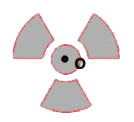Two straight lines rotate about two fixed points (−a,0)and(a,o). If they start from their position of coincidence such that oen rotates at the rate double that of the other, then
The point(−a,0) always lies
inside the curve
outside the curve
on the curve
none of these
The correct Answer is:C
To solve the problem step by step, we need to analyze the motion of the two lines rotating about the points (−a,0) and (a,0). Here's the detailed solution:
Step 1: Understand the Rotation of the Lines
We have two lines rotating about the points (−a,0) and (a,0). One line rotates at an angle θ and the other rotates at an angle 2θ (double the rate).
Step 2: Determine the Slopes of the Lines
The slope of the line rotating about (−a,0) at angle θ can be expressed as:
m1=tan(θ)
The coordinates of a point on this line can be expressed as:
y=m1(x+a)(1)
For the line rotating about (a,0) at angle 2θ, the slope is:
m2=tan(2θ)
The coordinates of a point on this line can be expressed as:
y=m2(x−a)(2)
Step 3: Use the Double Angle Formula for Tangent
Using the double angle formula for tangent:
tan(2θ)=2tan(θ)1−tan2(θ)
Let y=tan(θ)(x+a) from equation (1). Substituting m1 into the double angle formula gives:
m2=2y/(x+a)1−(y/(x+a))2
Step 4: Set Up the Equations
From the slopes, we can equate the two expressions for y:
tan(2θ)=2yx+a⋅(x+a)2(x+a)2−y2
Cross-multiplying gives:
2y(x+a)=y((x+a)2−y2)
Step 5: Simplify the Equation
Rearranging and simplifying leads to:
y2+2y(x+a)−(x+a)2=0
This is a quadratic equation in y.
Step 6: Determine the Locus of the Point
To find the locus of the point (−a,0), substitute x=−a and y=0 into the equation:
02+2(0)(−a+a)−(−a+a)2=0
This simplifies to:
0=0
indicating that the point (−a,0) satisfies the locus equation.
Step 7: Conclusion
Since the point (−a,0) satisfies the locus equation derived from the rotating lines, it lies on the curve formed by the intersection of the two lines.
Final Answer
The point (−a,0) always lies on the curve.
---
We have two lines rotating about the points (−a,0) and (a,0). One line rotates at an angle θ and the other rotates at an angle 2θ (double the rate).
The slope of the line rotating about (−a,0) at angle θ can be expressed as:
m1=tan(θ)
The coordinates of a point on this line can be expressed as:
y=m1(x+a)(1)
m2=tan(2θ)
The coordinates of a point on this line can be expressed as:
y=m2(x−a)(2)
Using the double angle formula for tangent:
tan(2θ)=2tan(θ)1−tan2(θ)
Let y=tan(θ)(x+a) from equation (1). Substituting m1 into the double angle formula gives:
m2=2y/(x+a)1−(y/(x+a))2
From the slopes, we can equate the two expressions for y:
tan(2θ)=2yx+a⋅(x+a)2(x+a)2−y2
Cross-multiplying gives:
2y(x+a)=y((x+a)2−y2)
Rearranging and simplifying leads to:
y2+2y(x+a)−(x+a)2=0
This is a quadratic equation in y.
To find the locus of the point (−a,0), substitute x=−a and y=0 into the equation:
02+2(0)(−a+a)−(−a+a)2=0
This simplifies to:
0=0
indicating that the point (−a,0) satisfies the locus equation.
Since the point (−a,0) satisfies the locus equation derived from the rotating lines, it lies on the curve formed by the intersection of the two lines.
The point (−a,0) always lies on the curve.
Topper's Solved these Questions
- MATHEMATICS BOOK - FIITJEECHAPTER - MATHEMATICS EXERCISE - NUMERICAL BASED QUESTIONS
23 Videos
- MATHEMATICS BOOK - FIITJEECHAPTER - MATHEMATICS EXERCISE - NUMERICAL DECIMAL BASED QUESTIONS
15 Videos
- MATHEMATICS BOOK - FIITJEECHAPTER - MATHEMATICS EXERCISE - MCQ (MULTIPLE CORRECT)
30 Videos
- MATHEMATICAL REASONING BOOK - FIITJEECHAPTER - MATHEMATICAL REASONING EXERCISE - ASSIGNMENT PROBLEMS (OBJECTIVE) LEVEL-2
18 Videos
- MATHEMATICS TIPSBOOK - FIITJEECHAPTER - MATHEMATICS TIPSEXERCISE - NUMERICAL DECIMAL BASED QUESTIONS
21 Videos
Similar Questions
Two straight lines rotate about two fixed points (-a, 0) and (a, 0) in antic clockwise direction. If they start from their position of coincidence such that one rotates at a rate double of the other, then locus of curve is
View SolutionTwo rods are rotating about two fixed points in opposite directions. If they start from their position of coincidence and one rotates at the rate double that of the other, then find the locus of point of the intersection of the two rods.
View Solution
Knowledge Check
A straight line passes through the points (5,0) and (0,3). The length of perpendicular from the point (4,4) on the line is
A15√34B√172C172D√172A straight line passes through the points (5 , 0) and (0,3) . The length of the perpendicular from the point (4 , 4) on the line is
A√172B√172C15√34D172What is the rotational symmetry about the point O and line of symmetry of the given figure?
 ARotational symmetry 90 and line of symmetry as 4BRotational symmetry 120 and line of symmetry as 3CRotational symmetry 120 and line of symmetry as 4DRotational symmetry 90 and line of symmetry as 3
ARotational symmetry 90 and line of symmetry as 4BRotational symmetry 120 and line of symmetry as 3CRotational symmetry 120 and line of symmetry as 4DRotational symmetry 90 and line of symmetry as 3
A straight line passes through the points (5,0) and (0,3). The length of perpendicular from the point (4,4) on the line is
View SolutionTwo straight lines pass through the fixed points (±a,0) and have slopes whose products is p>0 Show that the locus of the points of intersection of the lines is a hyperbola.
View SolutionThe straight line y=x−2 rotates about a point where it cuts x-axis and become perpendicular on the straight line ax+by+c=0 then its equation is
View SolutionA straight line is drawn from a fixed point O meeting a fixed straight line in P. A point Q is taken on the line OP such that OP.OQ is constant. Show that the locus of Q is a circle.
View SolutionRotation turns an object about a fixed point which is known as centre of rotation.
View Solution
